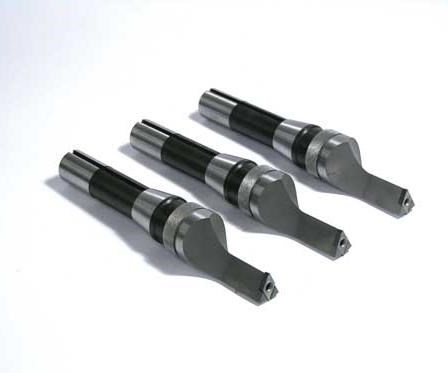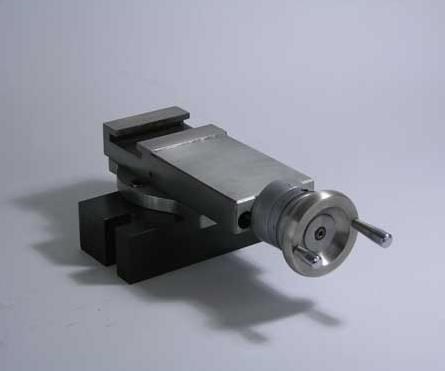Precision Lathe Operations on a CNC Mill
Sometimes a shop doesn’t do enough turning work to justify the purchase of a CNC lathe. But when it needs to produce precision turned parts, even if for a very small lot size, the shop needs a solution.
Sometimes a shop doesn’t do enough turning work to justify the purchase of a CNC lathe. But when it needs to produce precision turned parts, even if for a very small lot size, the shop needs a solution.
Such was the case for Sturges DesignWorks, a company in Portland, Ore., that provides automation and design engineering solutions in a variety of industries, including medical products, electronics, fixturing and tooling, and research and development. The company was working with a client who needed a special machine built that required substantial CNC lathe work. But Sturges didn’t have a lathe. “CNC lathes are expensive, take up much needed floor space, and have a steep learning curve,” explains Dan Sturges, company CEO. He considered a CNC mini lathe, but found that it would not be precise, rigid or accurate enough for the work required.
To address the issue, the company developed what it calls the Sturges Turning Head system to bridge the gap between traditional, full-featured CNC lathes and low-productivity, small CNC mini lathes. “I had always wondered why we couldn’t somehow do precision CNC lathe work on a CNC milling machine,” Mr. Sturges says. “The problem is, even if you attach a lathe tool to the mill spindle and lock it, there’s still a tiny bit of play that makes it impossible to maintain a standard of precision. So we developed a turning bar toolholder that places the tip of the tool at the spindle’s center of rotation, eliminating the slight play in the tool tip and providing the precision and accuracy needed for professional, high-quality lathe work on a mill.” Based on this principle, the company built the prototype for the Turning Head system, which is capable of external turning, facing and contouring operations. An optional cross slide accessory bolts onto the table, allowing for plunge operations such as parting and grooving.
The Turning Head spindle—the equivalent of a lathe headstock—is made of steel and cast iron and uses premier Grade 7 pre-loaded ball bearings that are lubricated for life. The standard model has less than 50 millionths of an inch runout, and the super-precision model has less than 20 millionths. It has a large, through-bore 5C spindle with a 4-degree taper mount nose.
The system comes with a set of three turning bars, each with an R8 or 3/4-inch straight. The universal design allows left-hand, right-hand and center cutting operations simply by rotating the tool. Tool changes between different turning operations are eliminated. The toolholders are available in three sizes (1/32 radius, 1/64 radius and 1/128 radius) and maintain cutter concentricity to less than 0.001-inch TIR.
Operating the system is straightforward. The operator places a piece of stock in the spindle, tightens the collet, turns on the unit, and hits “Go” on the CNC interface. The system allows the machinist to set up a job on a mill and crank out smooth, accurate parts in a repetitive way. Operating on the existing milling machine’s software, the CNC program provides fast, efficient operation without the need to learn new software.
It’s hard to justify the expense of a multi-axis CNC lathe when only one, ten or 100 parts are required. “Machinists, engineering departments, automation groups, tool makers, mold makers and machine builders often don’t have the need for high-volume production,” Mr. Sturges says. “What they need is an economical way to create precision parts.”
The Turning Head system can fill that void. Indexing capability allows indexing the work and seamlessly transitions between milling and turning operations on the same part in the same setup. Multi-axis capability is achieved on an existing machine in the shop. According to Mr. Sturges, “Parts made with this system are indistinguishable from parts made on a CNC lathe—same accuracy, same repeatability, same quality.” In a sense, it’s the best of both worlds.
Related Content
Seco Tooling Lineup Promotes Optimized Part Processing
The company’s expanded tooling lineup is aimed at applications ranging from general ISO turning to high-volume hard turning and deep-hole drilling.
Read MoreAutomation Breakthroughs Revolutionize Precision Machining for Complex Parts
Marubeni Citizen-Cincom delivers custom solutions to address some of the biggest challenges in precision machining from handling small parts, to robot integration and unique tooling needs.
Read MorePSZ Turn Modular Quick-Change System for Swiss Lathes
Sumitomo’s PSZ Turn system provides good ergonomics and efficiency by offering a fast, reliable process and convenient cassette changes.
Read MoreLyndex-Nikken Collet Chuck Increases Gripping Force
SK collet chucks enables for access to tight spaces and provides better clearance, making it ideal for machining complex parts.
Read MoreRead Next
When To Combine Milling And Turning
Turn/Mill technology enables users to complete a workpiece in a single handling. This article looks at some of the criteria that make application of this multi-tasking productive.
Read More5 Aspects of PMTS I Appreciate
The three-day edition of the 2025 Precision Machining Technology Show kicks off at the start of April. I’ll be there, and here are some reasons why.
Read MoreDo You Have Single Points of Failure?
Plans need to be in place before a catastrophic event occurs.
Read More




.jpg;maxWidth=150;quality=70)





.png;maxWidth=300;quality=90)











.jpg;maxWidth=400;quality=70)


